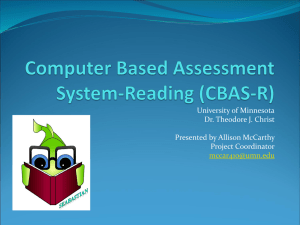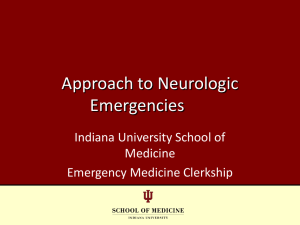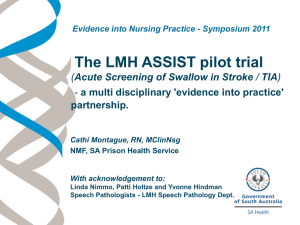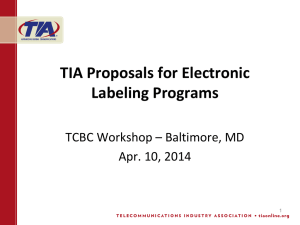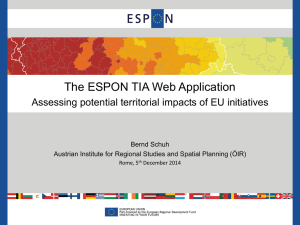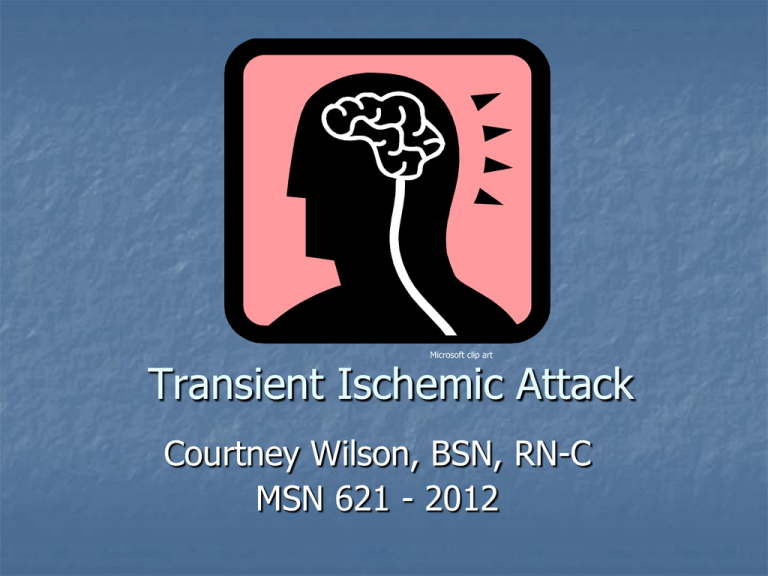
Microsoft clip art
Transient Ischemic Attack
Courtney Wilson, BSN, RN-C
MSN 621 - 2012
AT THE COMPLETION OF THIS
TUTORIAL THE LEARNER WILL:
1. Identify the pathophysiology of a transient
ischemic attack (TIA).
2. Identify the clinical implications of a TIA.
3. Identify TIA diagnostic tools.
4. Identify medical treatments for a TIA.
5. Identify the risk factors for a TIA.
6. Identify measures to prevent a TIA.
Microsoft clip art
WHAT TO EXPECT
You will be presented material about TIAs and given an
interactive quiz at the end of each section. Rationales
for answers will be provided.
At the end of the tutorial a case study is presented,
allowing you to apply your knowledge of TIAs to clinical
practice.
“HOVER AND DISCOVER.” When you see words
underlined in TEAL, hover over them to receive
additional information on the subject.
Please utilize the provided hyperlinks. Double click on
the underlined websites in TEAL to access them
directly.
ENJOY AND HAVE FUN!
A TIA IS
A transient cerebral blood flow disruption which affects a
focal portion of the brain, causing temporary ischemia
without acute infarction.
A transient ischemia attack of the brain causing
neurological deficits which last for less than 24 hours;
most often less than 1 to 2 hours. TIA symptoms are RAPID
in onset!
Caused by atherosclerotic disease of the cerebral vessels
and emboli that temporarily disturb blood flow to a
portion of the brain. This blockage resolves on its own
before permanent neurological damage occurs.
Clot formation may result from… (Porth & Matfin, 2009)
Hypercoagulability
Vessel spasm
Disturbed blood flow
A TIA IS
WARNING
STROKE
Microsoft clip art
Known as a “warning” or “mini” stroke.
4 to 8% of patients are at risk of having a stroke
within 1 month of having a TIA! (American Stroke Association, 2012)
Also described as a “zone of penumbra without
central infarction.” (Porth, 2009)
Penumbra means “halo.”
During the stroke process there is usually a central core or
“zone” of ischemic cells. This area is surrounded by an
ischemic band or area of poorly perfused cells called the
PENUMBRA. There is NO cell infarction that occurs during a
TIA!
Clot or plaque
in the cerebral
vessel
Focal
ischemic
area in the
brain
“Zone” of
ischemic
cells
Penumbra
surrounds
this area
A TIA IS
Brain cells of the Penumbra receive collateral blood
supply from nearby vessels. The “support” vessels
anastomose with branches of the occluded vessel to
provide supplemental perfusion.
The ischemic area of the brain experiences temporary
‘electrical failure’ during the TIA, causing neurological
deficits. Because perfusion is quickly restored, the
structure of the brain cell is maintained and permanent
sequelle do not occur.
Ischemic area
Note the dark grey area
surrounding the light grey
ischemic cells. This is the
PENUMBRA.
Stroke Center (n.d.) Used by permission.
A TIA IS
A type of “brain attack” where the penumbra
cells SURVIVE!
Cerebral vessel survival depends on successful
TIMELY return of adequate circulation to the
ischemic area.
Remember:
TIA = ZONE OF PENUMBRA
WITHOUT CENTRAL INFARCTION.
Microsoft clip art
REVIEW QUESTION
Microsoft clip art
A TIA is a ___________blockage (clot)
that occurs in a focal part of the brain.
permanent
partial
transient
FALSE
FALSE
TRUE
TIA symptoms resolve once
the blood flow returns to the
cerebral artery that is
affected.
The blockage is complete,
but does not remain long
enough to cause permanent
brain damage.
TIA symptoms “come and
go”. They resolve once blood
flow is restored to the area
of the brain affected.
REVIEW QUESTION
Microsoft clip art
Focal ischemic cerebral neurological deficits
(TIAs) usually last less than ______.
24 – 48 hrs
FALSE
Not quite, this is a little too
long. Symptoms last less
than 24 hrs.
1 week
FALSE
This is too long for TIA
symptoms. Stroke symptoms
may last this long.
1 – 2hrs
TRUE
TIA symptoms last less than
24hrs, usually less than 1 to
2 hrs.
CLINICAL IMPLICATIONS OF A TIA
Symptoms of a TIA are EXACTLY the same as for a
STROKE!
Is considered a critical situation!
The specific manifestations of a TIA are determined by…
The affected cerebral artery.
The area of brain tissue supplied by that vessel.
The adequacy of the collateral circulation. (Porth, 2009)
TIA SYMPTOMS =
AN EMERGENCY!
=
Microsoft clip art
Microsoft clip art
CLINICAL IMPLICATIONS OF A TIA
Symptoms of a TIA are always sudden in onset,
focal and usually unilateral (one-sided). (Porth, 2009)
TIA symptoms (Porth, 2009)
Weakness to the face, arm, leg.
(Most common)
Microsoft clip art
Unilateral Numbness.
Parasthesia
Confusion, trouble speaking or understanding.
Aphasia
???
Dysarthria
Microsoft clip art
CLINICAL IMPLICATIONS OF A TIA
TIA Symptoms… (Porth, 2009)
Trouble seeing in one or both eyes.
Amaurosis fugax
Hemianopia
Microsoft clip art
Trouble walking, dizziness, loss of balance or coordination.
Ataxia
Severe headache with no known cause.
Cephalgia
Microsoft clip art
REVIEW QUESTION
Microsoft clip art
The most common manifestation of a TIA
is______. This symptoms usually presents
unilaterally.
Dysarthria
Weakness
Hemanopia
FALSE
TRUE
FALSE
Sorry, this is not the most
common TIA symptom. It
means to have slurred
speech.
Unilateral weakness to the
face & arm, and sometimes
leg is the most common TIA
symptom.
Good try, but this is not the
most common symptom of a
TIA. It means to have lost ½
of your visual field.
REVIEW QUESTION
Microsoft clip art
The manifestations of a TIA are _________
in onset and usually ___________ in
presentation.
Progressive/
Bilateral
FALSE
Sorry, TIA symptoms are
rapid in onset and usually
affect only one side of the
body. This symptom would
require additional testing.
Sudden/
Unilateral
TRUE
This is correct! TIA
symptoms due occur
suddenly and usually affect
one side if the body.
Slow/
generalized
FALSE
Not quite, remember that
TIA symptoms occur rapidly
and are unilateral in nature.
DIAGNOSING A TIA
The diagnostic evaluation should aim to…
Determine the presence of hemorrhage or ischemia
Identify the stroke or TIA mechanism (cause)
Characterize the severity of the clinical deficits
Unmask the presence of risk factors.
Microsoft clip art
(Porth, 2009)
DIAGNOSING A TIA
1. Complete History
Documentation of previous TIAs or strokes.
The time of onset, pattern and rapidity of system
progression.
Specific focal systems. (Porth, 2009)
Microsoft clip art
2. Physical and neurological exam.
National Institute of Health neurological exam
NIH Stroke Scale (NIH)
(Double click above to check it out!)
http://www.ninds.nih.gov/doctors/NIH_Stroke_Scale.pdf
DIAGNOSING A TIA
3. Imaging Studies.
BRAIN IMAGING – document the brain infarction.
Microsoft clip art
CT Scan of the brain – Preferred imaging in an
emergent/acute setting to rapidly rule out a cerebral
hemorrhage diagnosis.
CAUTION: THE TIA PATIENT WILL HAVE A NEGATIVE
CT SCAN OF THE HEAD!
Magnetic Resonance Imaging (MRI) of the brain –
Preferred imaging for ischemic lesions of the brain.
DIAGNOSING A TIA
VASCULAR IMAGING – identifies the anatomy and
pathologic processes of the related blood vessels. (Porth
2009)
CT Angiography (CTA):
Magnetic Resonance Angiography (MRA):
Catheter based “conventional” angiography :
Microsoft clip art
Ultrasonography :
Duplex Ultrasonography: assessment of the carotid
bifurcation.
Transcranial Doppler: assessment of the flow velocities
in the cerebral circulation.
????
????
CASE STUDY
Microsoft clip art
Patient: 68 yr old African American male, Mr. G, presents to the
ED with reports of numbness and tingling to his right face, right
arm, and slight difficulty with word choice for the past 35 minutes.
No facial asymmetry noted. He also reports a moderate to severe
headache since yesterday. Patient ran out of his BP meds 1 week
ago and states he forgot to refill them. He tells the RN that his BP
was “normal” when he checked it a month ago.
MEDS: Lisinopril 40mg/day & Metformin 1000mg/BID. Patient states he
isn’t the best at taking his medications daily.
VITALS: 178/98, 96, 18, 98.6, Pox 96% at room air.
Glucose /capillary : 120mg/dL
NIH score = 2
PAST MEDICAL HISTORY: - NKDA - Diabetes Mellitus/Type II
- HTN, Hyperlipidemia, recent cholesterol of 190.
- No surgeries or previous hospitalizations.
REVIEW QUESTION
Microsoft clip art
What is the INITIAL diagnostic imaging test that would be
completed when Mr. G arrives to the ER with his symptoms
to provide a differential diagnosis?
MRI of the brain
CT of the head
without contrast
FALSE
FALSE
MRI is a superior test for
diagnosing ischemic lesions
in the brain, but it is not a
fast test. The CT scan of the
head will quickly provide a
differential diagnosis (stroke
vs TIA). Time is brain
function!
Duplex
ultrasonography
TRUE
The CT of the head will
quickly differentiate between
a stroke and a TIA. This will
help direct the patient’s plan
of care.
This is a fast noninvasive test
that will provide information
to the patency of the carotid
arteries and the blood flow to
the brain. This will assist in
possible surgical options if a
large blockage presents. This
is not the initial imaging that
would be completed.
TIA TREATMENT
TIA treatment is focused on preventing recurrent TIAs,
strokes and medical complications.
“The risk of stroke is highest in the first week after
stroke or TIA.” (Porth, 2009, p. 1324)
Early implementation of antiplatelet agents in most
cases is the standard of care.
Current treatment options for TIA include
ASPIRIN - first line of medical treatment.
TICLOPIDINE
CLOPIDOGREL
CAROTID ENDARDECTOMY
(Porth, 2009)
TIA TREATMENT
According to the American Heart Association’s journal
Microsoft clip art
Stroke.
Depression is more prevalent among stroke and transient
ischemic attack survivors than in the general population. It is
underdiagnosed and undertreated.
Researchers, analyzing 1,450 adults with ischemic stroke
(blockage of a blood vessel in the brain) and 397 with TIA,
found:
Three months after hospitalization, depression affected 17.9
percent of stroke patients and 14.4 percent of TIA patients.
At 12 months, depression affected 16.4 percent of stroke patients
and 12.8 percent of TIA patients.
Nearly 70 percent of stroke and TIA patients with persistent
depression still weren’t treated with antidepressant therapy at
either the 3 or 12 month intervals.
OUTCOME: It is important for providers to screen for
depression on follow-up after both stroke and TIA.
http://newsroom.heart.org/pr/aha/depression-has-big-impact-on-stroke-231095.aspx
REVIEW QUESTION
Microsoft clip art
Mr. G’s CT of his head was NEGATIVE. It has now been 35 minutes
since he has arrived to the ED. His stroke symptoms have resolved.
His BP is lower at 145/76, rate 78 after taking his Lisinopril 40mg
which he is prescribed daily. DIFFERENTIAL DIAGNOSIS = TIA.
What other medication will they most likely add to his daily
medication regime? He reports no adverse reactions to any
medications.
Clopidogrel
FALSE
True, this medication can be
used to treat recurrent TIAs,
but this is not a first line
medication for TIA
prevention.
Aspirin
TRUE
One adult Aspirin/day is the
most common first line
medication for preventing
future TIAs.
Ticlopidine
FALSE
This medication is a first line
drug for TIA prevention, but
it is usually reserved for
those who are unable to
tolerate aspirin.
TIA RISK FACTORS
Unmodifiable factors
Age, Sex, Race, Heredity
The incidence of stroke INCREASES with age.
Stroke incident is greater among men than women’s
at younger ages, but not at older ages.
African Americans have almost 2x the risk of initial
stroke than caucasians.
Familial history of strokes/ TIAs.
(Porth, 2009)
TIA RISK FACTORS
Modifiable Factors
Hypertension –powerful determinant of stroke risk!
Hyperlipidemia
Smoking
Diabetes
Heart Disease (Atrial Fibrillation, Wall motion defects)
Carotid disease
Coagulation disorders
Obesity/Inactivity
Heavy alcohol use
Cocaine use
Microsoft clip art
Microsoft clip art
(Porth, 2009)
REVIEW QUESTION
Microsoft clip art
What is Mr. G’s most predominant modifiable
stroke/TIA risk factor?
Hyperlipidemia
African American
Hypertension
TRUE
FALSE
True, this a modifiable stroke
risk factor, but not the most
predominant for Mr. G.
FALSE
African Americans do have
higher incidence of stroke vs.
Caucasians, but this is not a
modifiable risk factor.
HTN is a powerful
determinant of stroke/TIA
risk. Mr. G’s BP is elevated
and he hasn’t taken his HTN
meds for 1 week. You must
discuss with him the
importance of medication
compliance in preventing
future TIAs or strokes!
TIA PREVENTION
Prevention
is key!
Microsoft clip art
Treatment and management of modifiable risk
factors offers the best opportunity to prevent cerebral
ischemic events. (Porth 2009)
Primary prevention of stroke by early detection.
IMMEDIATE TREATMENT IS NEEDED AT THE FIRST SIGN OF
STROKE!
Be proactive with your patients regarding managing their
modifiable risk factors, don’t wait until an ischemic event occurs!
Promote the importance of…
Medication compliance.
Daily exercise, goal of 30 minutes/day.
Smoking cessation.
Refraining from illegal drug or ETOH use.
Chronic disease management
- (HTN/CAD/DM/A-fib)
REVIEW QUESTION
Microsoft clip art
What will be the most effective PREVENTATIVE
measure Mr. G can do to prevent future TIAs or strokes.
Exercise
Take his BP
everyday
Medication
compliance
FALSE
FALSE
TRUE
True, this is a great
preventative measure, but
not the most effective for Mr.
G at this time.
Although this action will allow
for better HTN monitoring,
it unfortunately will not
prevent future TIAs/ strokes.
Mr. G’s BP was elevated and
he hadn’t taken his HTN
meds for 1 week. He may
have prevented his TIA had
he been taking his meds.
Let’s review what you’ve learned
in this tutorial.
The pathophysiology of a TIA.
The clinical implications of a TIA.
How a TIA is diagnosed.
Common treatments for a TIA.
The risk factors of a TIA.
TIA prevention.
Microsoft clip art
LITERATURE CITED
American Stroke Association (January/February 2009) Why Rush? Stroke Connection.
Retrieved March 15, 2012 from
http://www.strokeassociation.org/STROKEORG/AboutStroke/TypesofStroke/TIA/Transient
-Ischemic-Attack_UCM_310942_Article.jsp
American Stroke Association (March 2012) Depression has big impact on stroke, TIA
Survivors. Stroke. Retrieved March 15, 2012 from
http://newsroom.heart.org/pr/aha/depression-has-big-impact-on-stroke-231095.aspx
Microsoft Office 2003 Clip Art
National Institute of Health (October 2003) National Institute of Health Stroke Scale for
doctors. Retrieved March 1, 2012 from
http://www.ninds.nih.gov/doctors/NIH_Stroke_Scale.pdf
Porth, C. M., & Matfin, G. (2009). Pathophysiology Concepts of Altered Health States (8th
ed.). Philadelphia, PA: Lippincott Williams& Wilkins.
Stroke Center (n.d.). The Ischemic Penumbra. Permission received to use image.
Retrieved March 15, 2012.
http://www.strokecenter.org/professionals/brain-anatomy/cellular-injury-duringischemia/the-ischemic-penumbra/


